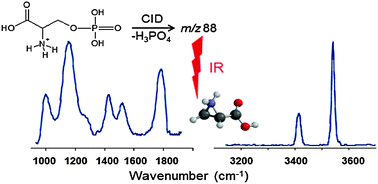Kinetic control in the CID-induced elimination of H3PO4 from phosphorylated serine probed using IRMPD spectroscopy†
Abstract
InfraRed Multiple Photon Dissociation (IRMPD) spectroscopy was used to assay the structural features of the fragment ions resulting from the elimination of H3PO4 in the Collision-Induced Dissociation (CID) of protonated serine. The results are interpreted with the aid of density functional theory calculations. Experiment and theory point to an aziridine-ring structure, implying participation of the vicinal amino group in the formation of this species. This finding constitutes a benchmark for investigating the same process in the CID of phosphorylated peptides.


 Please wait while we load your content...
Please wait while we load your content...